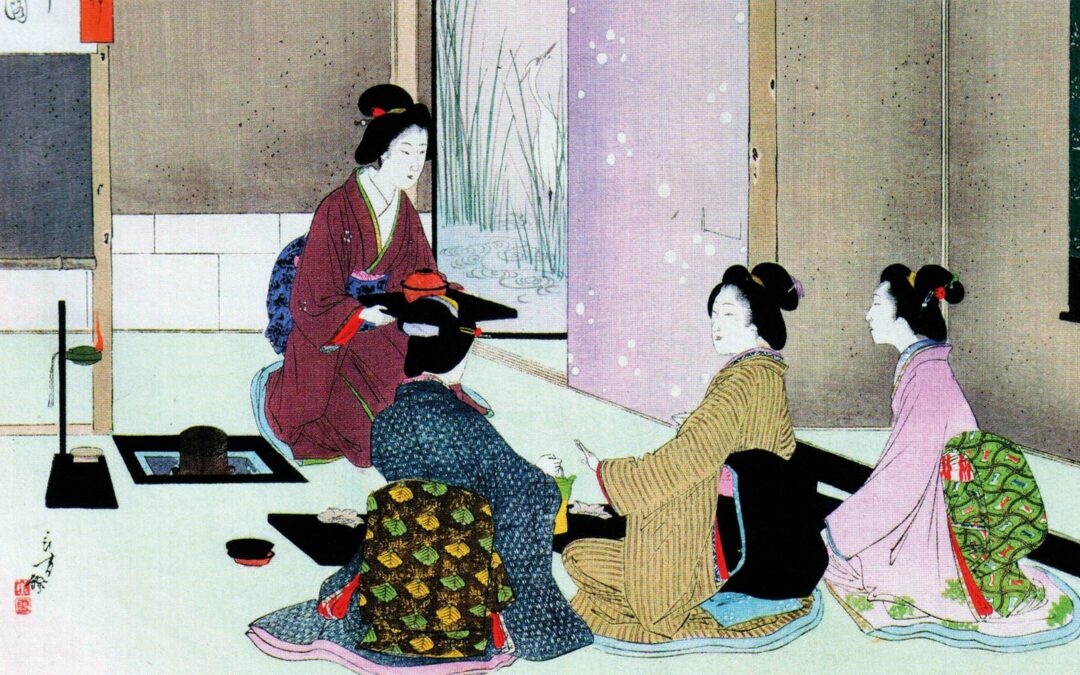Visitors have always been enthralled by the rich culture and lengthy history of customs in Japan. The ritual of drinking tea is one fascinating example. The Japanese tea ceremony is more than simply a social event where people get together to drink tea; it also has profound philosophical importance.
Brewing Unity and Harmony: The Philosophical Underpinnings
The tea ceremony involves much more than merely steeping tea leaves in hot water. It’s quite dance-like, with each element standing in for a different facet of existence and the natural environment.
- Harmony (和, wa): It’s a picture-perfect illustration of peace and unity among guests, host, and environment. Environment, body language, and even where to put the fork are all ways to promote harmony.
- Respect (敬, kei): The purpose of this guideline is to demonstrate mutual respect between the host and guest. Every aspect of the tea ritual, from the offering to the drinking, is performed with the highest respect.
- Purity (清, sei): Both the host and the guest will be showing their appreciation for each other by following this rule. From the preparation until the consumption of the tea, the utmost deference is shown at every step.
- Tranquility (寂, jaku): After adhering to the first three rules, one may relax and enjoy the here and now.
Central to the tea ceremony is the concept of “Ichi-go ichi-e,” or “oneness through diversity.” Each gathering, as suggested by the phrase’s literal translation, “One time, one meeting,” is unique and will never be duplicated.
The Roots of the Tea Ceremony: Not Just a Storm in a Teacup
The tea ceremony’s significance in Japanese culture has endured for centuries. But it’s important to remember that this festival honoring tea in Japanese culture didn’t suddenly become significant.
The Chinese were instrumental in shaping the modern tea ceremony as a cultural phenomenon. Tea was initially introduced to Japan by Chinese monks in the early Heian period (794-1185). The ethereal aspect of Japanese tea culture emerged as it simmered for millennia. Zen Buddhist ideals found a natural expression in the way Japanese monks prepared and drank tea.
The tea ritual clearly influenced the development of Zen Buddhism. Making and drinking tea has become more than just a beverage; it has become a time for contemplation and relaxation. Emptiness, tranquility, and transience are now commonly associated with the ritual as time has passed.
Tea Houses and Tools: More than Meets the Eye
As you get more knowledge about the tea ceremony, you’ll notice that every detail has been carefully considered. Tea houses, or Chashitsu, are works of art in themselves, and their designs often reflect the Wabi-Sabi philosophy of appreciating the imperfect and transient.
Every item used in these spaces has a purpose and carries symbolic weight:
- Chawan (tea bowl): symbolizes the vastness and depth of life and acts as a stand-in for the universe during the ritual.
- Chasen (tea whisk): used to prepare tea by adding tea powder to hot water; a metaphor for the interplay between opposites in life.
- Chashaku (tea scoop): As a connector between the bowl and the tea caddy, it symbolizes the path one takes through life.
Each individual instrument, gesture, and dance has deep cultural importance.
Beyond the Sip: Cultural and Social Impacts
The ritual’s influence extended well beyond the teahouse’s walls. Alliances, diplomatic missions, and political dialogues all relied heavily on these rites throughout early Japanese history. Samurai warriors, for instance, would have sporadic tea rituals to forge bonds and discuss tactics.
The tea ceremony is most effective when practiced in a group environment, where it promotes mutual understanding, cooperation, and open dialogue. Strong user ties form, and social boundaries collapse in this setting. It’s a great reminder that we need to stop what we’re doing and enjoy the company of the people around us rather than rushing from one thing to the next.
Brewing it Right: Tea in Japanese Culture Today
Even the ritual of drinking tea has evolved throughout time. While some contemporary processes have taken a more permissive attitude, others have kept rigorous standards in place. Beyond Japan, people from all over the world are drawn to the tea ceremony’s charm and are learning about and incorporating its customs into their own tea traditions.
Thoughtful appreciation, respect, and cognitive awareness are still fundamentally important to cultivate. These rituals are all the more important in today’s fast-paced society because they underscore the need to be present in a world where everything happens at breakneck speed.
The Japanese tea ceremony captures countless philosophical ideas, human emotions, and historical events. It represents more than simply a little portion of Japan’s vast cultural legacy. The tea ceremony is a representation of Japan’s unchanging regard for beauty, simplicity, and the fleeting nature of life, from its humble roots to its enormous relevance today. And as you savor that wonderfully prepared cup of tea, remember that this occasion, this group of people, and this taste will never again exist.

